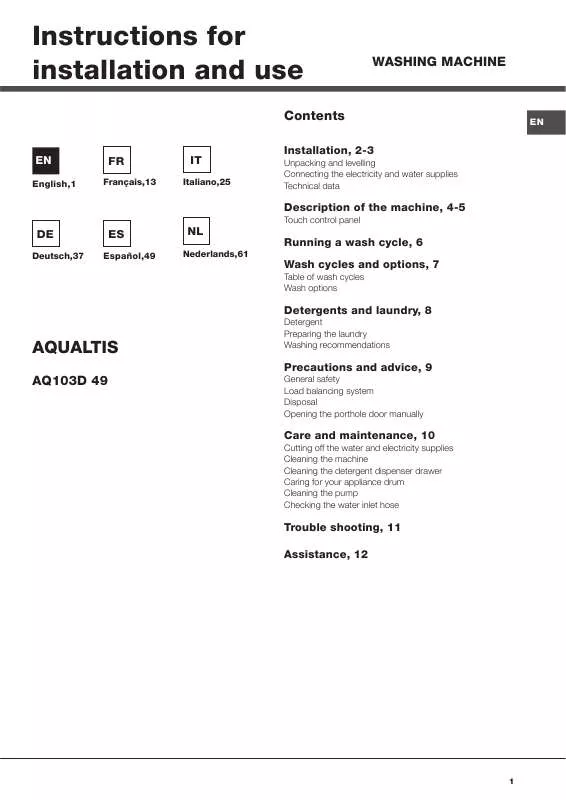Detailed instructions for use are in the User's Guide.
[. . . ] Instructions for installation and use
Contents
EN
English, 1
WASHING MACHINE
EN
FR
Français, 13
IT
Italiano, 25
Installation, 2-3
Unpacking and levelling Connecting the electricity and water supplies Technical data
Description of the machine, 4-5 DE
Deutsch, 37
ES
Español, 49
NL
Nederlands, 61
Touch control panel
Running a wash cycle, 6 Wash cycles and options, 7
Table of wash cycles Wash options
Detergents and laundry, 8
AQUALTIS
AQ103D 49
Detergent Preparing the laundry Washing recommendations
Precautions and advice, 9
General safety Load balancing system Disposal Opening the porthole door manually
Care and maintenance, 10
Cutting off the water and electricity supplies Cleaning the machine Cleaning the detergent dispenser drawer Caring for your appliance drum Cleaning the pump Checking the water inlet hose
Trouble shooting, 11 Assistance, 12
1
Installation
EN
!This instruction manual should be kept in a safe place for future reference. If the washing machine is sold, given away or moved, please ensure the manual is kept with the machine, so that the new owner may benefit from the advice contained within it. Read these instructions carefully: they contain vital information relating to the safe installation and operation of the appliance. [. . . ] 2) Test wash cycle in compliance with regulation 2010/1061: set wash cycle with a temperature of 40°C. 3) Long wash cycle for cottons: set wash cycle with a temperature of 40°C. 4) Short wash cycle for cottons: set wash cycle with a temperature of 40°C. 5) Long wash cycle for synthetics: set wash cycle with a temperature of 40°C. Wash options
This option offers a highperformance wash due to 3 the greater quantity of water used in the initial phase 1 of the cycle, and due to the increased wash cycle 2 duration, is particularly useful for the removal of stubborn stains. If you desire bleaching, insert the extra tray compartment (3) into compartment 1. When pouring in the bleach, be careful not to exceed the “max” level marked on the central pivot (see figure). To bleach laundry without carrying out a full wash cycle, pour the bleach into the extra compartment 3, select the “Rinse” cycle and activate the “Super Wash” option . It cannot be used in conjunction with , , , , , ,
, , . Super Wash
By selecting this option, the efficiency of the rinse is increased and optimal residual detergent removal is guaranteed. It is particularly useful for skin which is sensitive to detergents. We recommend this option is used with a full load of washing, or when a large amount of detergent is required. It cannot be used in conjunction with , , , , . By selecting this option, the wash and spin cycles will be modified in order to reduce the formation of creases. At the end of the cycle the washing machine drum will rotate slowly; the “Easy Iron” and START/PAUSE indicator lights will flash. To end the cycle press the START/PAUSE button or the “Easy Iron” button. It cannot be used in conjunction with , , , , . If you select this option, the wash cycle duration will be reduced by up to 50%, depending on the selected cycle, thereby guaranteeing simultaneous water and energy saving. Use this cycle for lightly soiled garments. It cannot be used in conjunction with , , , , , , , , . Extra rinse
Easy Iron
Time Saver
7
Detergents and laundry
EN
Detergent
The type and quantity of detergent required depend on the type of fabric you are washing (cotton, wool, silk, etc. ), as well as its colour, the washing temperature, the level of soiling and the hardness of the water in the area. [. . . ] If the dwelling is on one of the upper floors of a building, there may be problems relating to water drainage, causing the washing machine to fill with water and drain continuously. Special anti-draining valves are available in shops and help to prevent this inconvenience. The wall drainage system is not fitted with a breather pipe. The wash cycle does not include draining: Some wash cycles require the drain phase to be started manually (see “Wash cycles and options”). [. . . ]


